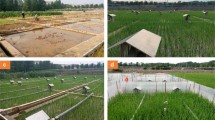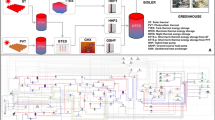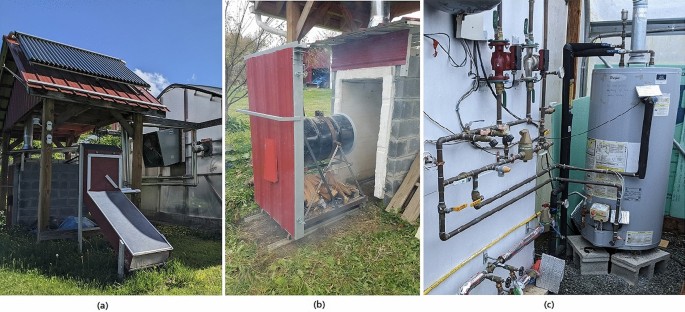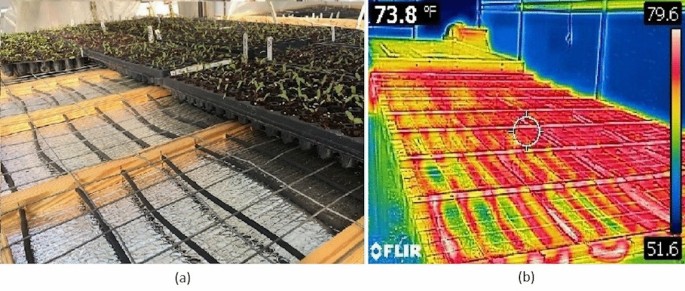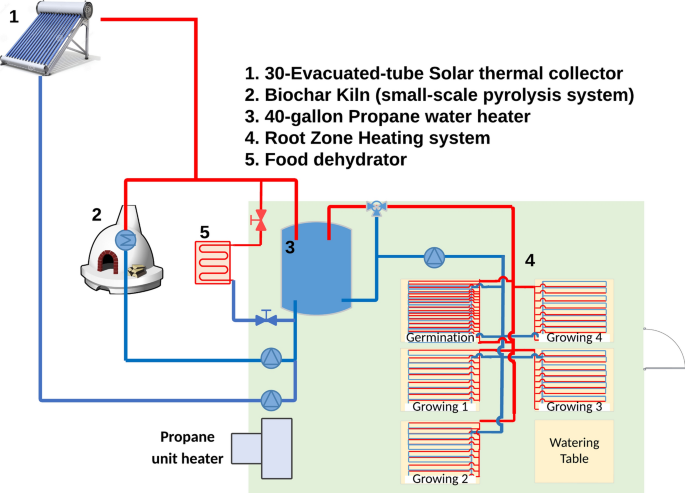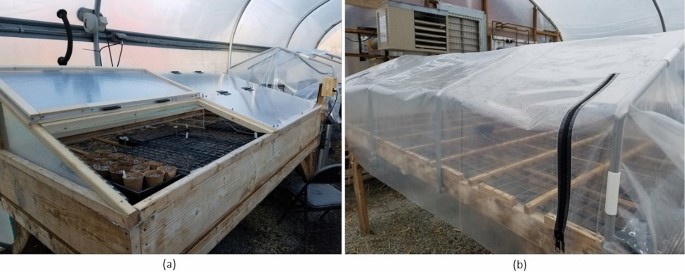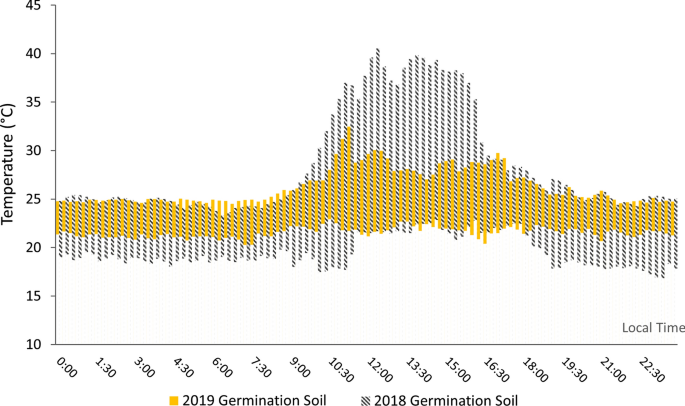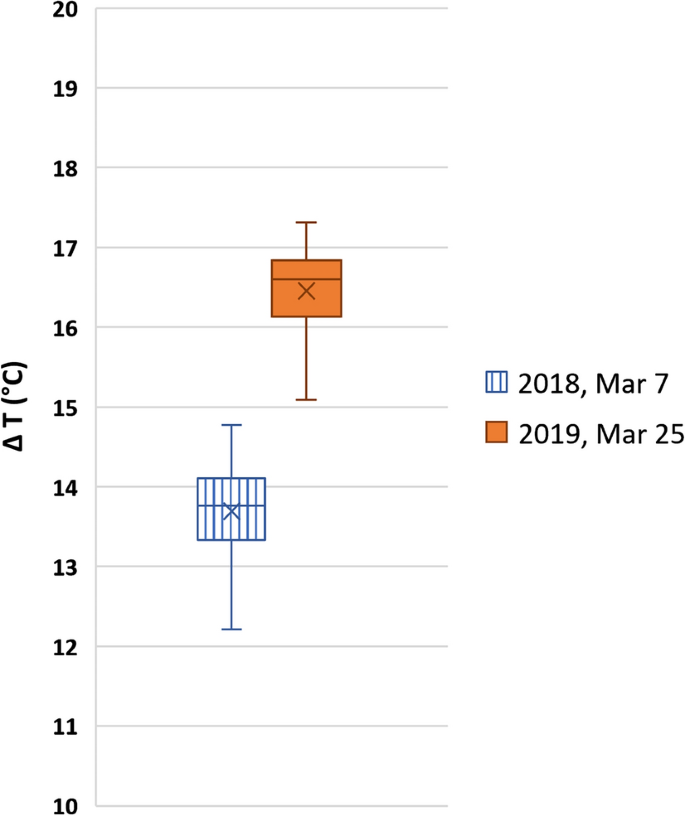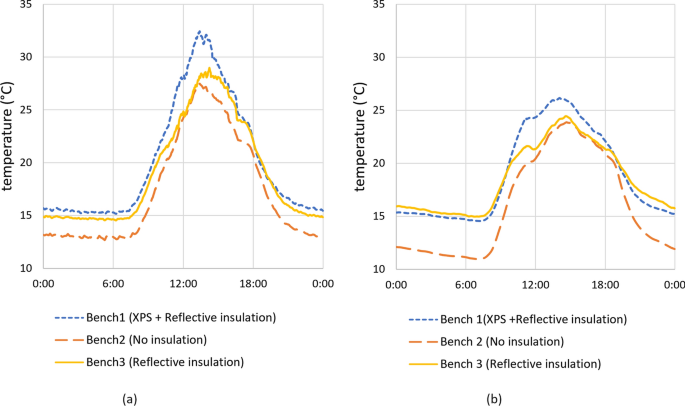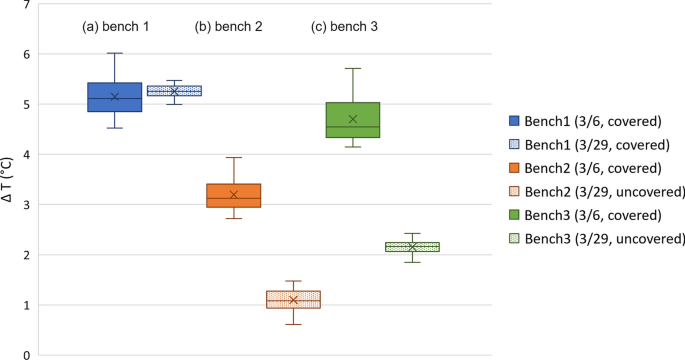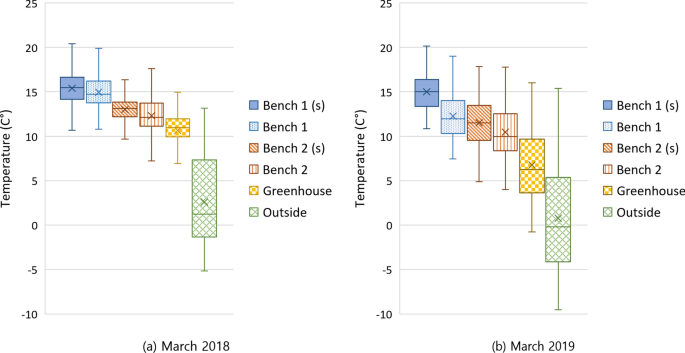Abstract
Appalachian State University's Nexus project designed an efficient greenhouse heating system that integrated renewable energy and root zone heating technology to reduce the greenhouse heating energy burden on local farmers and installed it at local cooperative farms. This study analyzed 5 years of data from 2018 to 2022 to investigate the energy savings and microclimate control effectiveness of the Nexus heating system installed at Springhouse Farm in North Carolina, USA. By varying bench cover materials, bottom insulation, and the number of loops of root zone tubing, the different soil temperatures required for plant types and growth stages were achieved with a single temperature controller. A root zone heating fluid of 32.2 ℃ satisfactorily maintained the germination soil between 20 and 25 ℃ in March 2019 with an average outside temperature of 4.8 ℃ and an average low temperature of − 0.4 ℃. Growing soil maintained an average temperature of 15 ℃ with bottom insulation and an average of 11–12 ℃ without bottom insulation. Compared to the conventional heating system (a forced-air propane unit heater alone), weather-adjusted propane consumption (propane usage divided by heating degree days) was reduced by 65% with the Nexus system alone and 45% with the Nexus system and unit heater together. It shows that the Nexus system has significantly reduced greenhouse heating energy consumption and maintained productive conditions. The renewable energy fraction ranged only 9–13% of the total thermal energy used due to the high inlet temperature entering the solar thermal collector. This can be improved by separating the heat storage and backup heat source.
Similar content being viewed by others
Avoid common mistakes on your manuscript.
1 Introduction
Research conducted by the Appalachian Sustainable Agriculture Project (ASAP) revealed that demand for locally grown produce exceeds current spending by 260% in western North Carolina (NC) [1]. This unmet demand for locally grown food indicates that the potential exists for increasing rural farmers’ income in the region [1, 2]. However, regional barriers, including a relatively short growing season and mountainous terrain, hinder this benefit by limiting the availability of locally grown produce along with consistency and access [3, 4]. Many farmers in the region are small-scale, family-owned, and struggle to maintain profitability with limited resources, resulting in low farming income and high rates of off-farm income sources [4,5,6]. In Southern Central Appalachia, which includes the area this study focuses on, 64% of farms had an average net loss of $10,734 per farm in 2017 [4].
Growing season extension through greenhouse production has been proposed as a key solution that simultaneously meets the demand for productivity improvement and local produce in the region [1, 2]. High tunnels’ relatively inexpensive installation cost ($32–47/m2) attracts small-scale farmers, so they are commonly used for growing season extension either by passive means or with active heating and ventilation systems [7]. However, the high heat loss rate (U-value: 6.4 W/m2·K) of polyethylene, the main material of the high tunnel, does not assure its envelope thermal insulation [8, 9]. In addition, the requisite energy costs exclude many rural farmers from being able to afford a heated greenhouse [10, 11]. Therefore, farmers in this region, with the late frost/freeze and cold snaps in spring, struggle to balance the economic viability of high tunnel crop production with energy costs.
Heating energy is one of the main overhead costs in greenhouse production in temperate climate regions and thus serves as a key factor in increasing agricultural productivity [12, 13]. Forced-air unit heaters are chosen by many growers because they are easy to install and have low initial costs, but the heated air rises upward, increasing the temperature difference between the inside and outside of the greenhouse ceiling, causing large heat loss [13]. Additionally, unit heaters are frequently installed high up in the greenhouse to secure cultivation space, and energy is wasted by heating the entire greenhouse rather than the plant areas.
Local heating and temperature control are efficient ways to save energy. Because each organ of a plant has a different sensitivity to heat, uniform temperature control of the entire greenhouse is not necessary [14]. Root zone heating (RZH) has been suggested as an effective heating method that simultaneously enhances plant health and saves heating energy [14]. Maintaining root zone temperatures within the optimal range, even at low greenhouse air temperatures, promotes root growth, activity, and nutrient uptake, leading to improved aboveground biomass and increased yields with reduced disease risk in studies of tomato crops [15, 16]. On the other hand, because root growth is sensitive to temperature, low root zone temperature restricts the growth of the entire plant even when optimal greenhouse air temperatures are provided [14, 17, 18].
Compared to conventional heating systems that heat air, RZH lowers the temperature difference between the greenhouse surface and the outside air, resulting in reduced conductive heat loss through the greenhouse plastic [19]. As warm roots allow lower ambient temperature, nighttime air temperature can be lowered by 2.8 to 5.6 ℃ when using RZH [13, 15, 20]. Several RZH methods, such as carbon crystal electrothermal film, hydronic tubing system, electric heating mats, and heated hydroponic system, have been investigated by researchers, demonstrating that RZH effectively controls soil temperature and provides a favorable environment [15, 16, 21, 22].
Another effort to save greenhouse energy is the application of renewable energy. Due to the rising cost, depletion, and negative environmental impact of fossil fuels, interest in the application of renewable energy in greenhouse production has increased, and technologies such as solar thermal systems and earth-air heat exchangers (EAHE) have been investigated for greenhouse [11, 23, 24]. These technologies include heat exchangers and heat storage such as soil, water, or phase change materials to increase greenhouse air temperature and maintain the appropriate temperature required for crops during the night [11, 23, 25]. Mehmet Esen [11] conducted an experimental study by designing a heating system that integrated biogas, solar thermal energy, and ground source heat pump under the winter climate conditions of eastern Turkey, and presented its potential as an efficient heating system [11]. However, most studies in greenhouse heating have been conducted in experimental greenhouses for short periods (usually less than a year) or through simulations, and few studies have been conducted on commercial greenhouses to demonstrate the effectiveness of their system design in a real production environment. In addition, only a few studies have investigated RZH performance in terms of greenhouse energy saving [14].
Appalachian State University’s sustainable energy project, the Nexus, developed an unique greenhouse heating system by integrating renewable energy and RZH to enhance energy savings and installed it at two local cooperative farms [26]. The heating system collects thermal energy from a solar thermal collector and a small-scale pyrolysis system (biochar kiln) and efficiently delivers heat to crops in a greenhouse through RZH system. We designed a biochar kiln and integrated it into the Nexus system. This innovative approach allows us to harness woody biomass, which is abundant in our region, for dual purposes: producing biochar as a valuable soil amendment and supplying heat energy during periods when solar energy is unavailable. [26]. This system was designed to be practical and capable of being added to an existing greenhouse.
The purpose of this study is to investigate the performance of the Nexus greenhouse heating system at Springhouse Farm in North Carolina, USA on microclimate conditions in terms of soil temperature and energy savings over 5 years of operation. The effectiveness of the under-bench insulation and bench covers installed in reducing heat loss from RZH was explored. Energy savings (propane consumption) were compared considering weather conditions each year. This study holds significant importance as it conducted a long-term evaluation of the RZH system, which integrates renewable energy within a commercial greenhouse. The evaluation focused on energy savings, with adjustments made based on weather conditions.
2 Research questions
To evaluate the system in terms of energy savings and productive microclimate conditions, the following questions were established:
-
How efficient are RZH systems compared to conventional forced air heating?
-
What is the share of renewable energy in the energy saved through the Nexus pilot system?
-
Can the heating system with improved bench covers maintain productive growing conditions without running forced air heating?
-
How does the heat loss, which depends on the material of the bench cover, affect the soil temperature?
-
How does under-bench insulation affect soil temperature?
3 Methodology
3.1 Description of greenhouse at springhouse farm and nexus heating system
Springhouse Farm has a 6.1 m by 9.1 m high tunnel greenhouse consisting of double polyethylene (PE) film and air-inflated between the layers. Inside the greenhouse, there are four growing benches and one germination bench. The greenhouse is used primarily for germination and propagation with work beginning in late January to early March. Before the proposed heating system was installed, they used a propane forced-air unit heater and electric heat mats for early germination.
In late 2017, the Nexus team designed and installed a greenhouse heating system to reduce propane consumption through renewable energy and efficient RZH heat distribution [26]. The system includes a solar collector, a biochar kiln, a food dehydrator, heat storage, and an RZH system (Fig. 1).
A heat transfer fluid, 50% propylene glycol–water solution, flows through the system to collect heat and deliver it to the plant rooting zone inside the greenhouse. The thermal collection components include a 30 evacuated-tube-solar thermal collector and a biochar kiln with a built-in heat exchanger. A differential controller controls circulation pumps to collect heat from renewable sources (e.g., sun or biomass) and delivers the heat to the heat storage, a 151.4-L propane water heater located inside the greenhouse. The propane water heater is a storage of heat collected from renewable energy system and is also used as a backup heat source.
The stored heat is distributed to crops on a germination bench and four growing benches through the RZH system (Figs. 2 and 3). All benches are 1.2 m wide and 2.4 m long. Christenbury’s report was referred for the RZH piping design of the Nexus system [20]. Manifold and main pipe were built with 25 mm, 19 mm, and 13 mm PVC pipes and fittings. The 25 mm main pipe was buried 0.3-m-deep in the ground. To distribute heat to the crop root zone (soil) on the benches, 6.35 mm PE drip irrigation tubing was installed due to its ease of acquisition and installation. The RZH tubing and the benches are connected in parallel to provide even flow rate (Fig. 3).
Schematic of the Nexus heating system at Springhouse Farm [26]
For sufficient heat transfer, the velocity must be kept below 2 m/s [20]. Flow rate is the product of velocity and pipe cross-sectional area, so a flow rate of 0.53 l/min or less in 6.35 mm PE tubing (4.32 mm ID) provides adequate heat to the soil. Based on the overall piping design, the total flow rate and friction loss were calculated to select a pump of an appropriate size for RZH circulation. Through preliminary experiments, we found that 37.8 ℃ water through 9 loops (4.9 m per loop) of 6.35 mm PE drip irrigation tubing on a 1.2 m by 2.4 m bench, the temperature of the soil in seedling trays were maintained at 12.8–15.6 ℃ evenly. Based on it, 9 loops of PE tubing were placed on each growing bench and 18 loops on the germination bench for a higher soil temperature.
The RZH circulation pump is regulated by the thermostat that senses the germination soil temperature. A mixing valve mixes the higher-temperature fluid from the heat storage (a 151.4-L propane water heater) with the lower-temperature fluid from the RZH return pipe to discharge the 32.2 ℃ mixed fluid to the RZH supply pipe. When all the heat collected from the renewable energy system is used up and the temperature of the fluid in the heat storage (water heater) drops below 32.2 ℃, the propane gas burner of the water heater ignites to maintain the temperature of the fluid above 32.2 ℃. The water heater has only two setpoints, 32.2 ℃ and 48.9 ℃, and it was set to the lower temperature of 32.2 ℃. During the warm season when heating is not needed in the greenhouse, the collected heat bypasses the water heater and is instead dumped into the food dehydrator where the heat can be used to dry food (Fig. 3).
3.2 Weather indicators and energy (propane gas) savings
Weather and propane gas usage data from 2016 through 2022 were compared. To compare each year’s weather conditions, heating degree days (HDDs) were calculated, and the number of days with freezing temperatures (below 0 ℃) was recorded. The HDDs is a measure of how much the outside temperature is below a certain level (base temperature) in degrees for given days and used to estimate the demand of heating energy in a building [27]. It is relative to a base temperature and obtained by subtracting the average temperature of the day from a base temperature:
where, HDDs is the sum of the differences between average temperature of day n (Tn-a) and a base temperature (Tbase) over given days. In this study, the unit heater’s setpoint temperature of 12.8 ℃ in 2016 and 2017 before using the Nexus system was set as a base temperature. All the HDDs from the day the greenhouse heating started to the end of May were summed to measure how cold the temperature was during the heating system operation. Because the weather varies every year as well as the period of the greenhouse heating, we compared the total propane consumption of each year by dividing it by HDDs.
3.3 Overall renewable energy gains
The overall heat gain from the Nexus system’s collection components (the solar thermal collector and the biochar kiln) was calculated in kJs from 2018 through 2022. All the heat energy gained from the solar collector and the biochar kiln is stored in the water heater (heat storage). Therefore, the temperature rise of the water heater during daytime (or biochar kiln operation) was used to calculate the amount of renewable energy gained. We looked at the days with no solar energy gained, such as cloudy and rainy days, and then averaged the water heater temperature on those days. This was the baseline water heater temperature, whereby only propane was used to heat the fluid.
The difference between the baseline temperature and the maximum water heater temperature of each day is the temperature rise by solar radiation or biochar kiln burn. Therefore, the thermal energy gained from the renewable energy system can be calculated by multiplying the total degrees of rise, mass, and specific heat of 50% propylene glycol–water solution. Total heat gains for renewable energy system can be calculated as follows:
where, Qtotal is total heat gains for renewable energy system; m is a mass of 50% propylene glycol–water solution; CP50 is the specific heat of the solution; tn,max is maximum temperature of the water heater of day n; and t0 is a baseline temperature of the water heater. We turned off the propane water heater when the daily low temperature outside was constantly above 10 ℃: May 8 in 2018, May 16 in 2019, May 14 in 2020, May 27 in 2021, and May 25 in 2022. After turning off the water heater, the water heater is not a backup heat source, and the soil is heated only with renewable energy at night. The minimum temperature of the water heater on each day was the baseline temperature after turning off the water heater.
The amount of thermal energy generated by a biochar kiln is influenced by many variables such as moisture content of the combustion chamber and biomass, so we refrained from using the biochar kiln during the greenhouse heating period to focus on the system’s solar energy collection for the reliable results.
3.4 Heat loss reduction with a lower U-value bench cover
Bench covers were used to trap heat. The bench cover used in 2018 was made of 0.15 mm thick polyethylene film. In 2019, we upgraded the bench covers to reduce heat loss (Fig. 4). We built zippered growing bench covers using 0.15 mm-thick polyethylene film for easy opening and closing, and they were placed over gable frames made of PVC pipes. The germination bench cover was constructed using wood frames and four 0.6 m by 1.2 m, 8 mm double wall polycarbonate panels. U-value, the overall heat transfer coefficient, of an 8 mm double wall polycarbonate panel is 3.03 W/m2·K, which is smaller than half of the U-value of single polyethylene film, 6.4 W/m2·K [8, 9].
The effect of the improved germination bench cover was evaluated by three methods: (1) the germination soil temperature, (2) the ignition time interval of the propane water heater, and (3) temperature difference between germination soil and greenhouse air. We compared the germination bench soil temperatures in March 2018 and March 2019. The temperature data collected every minute for March each year were converted into a daily distribution and depicted in one chart.
Since the RZH system is controlled by the germination soil temperature, we anticipated that the lower U-value of the upgraded germination cover would result in longer intervals between propane ignition in the water heater. We recorded the number of minutes that it took from one peak temperature to the next in the water heater between midnight and 8 a.m. on cold nights in March 2018 and March 2019.
3.5 Under-bench insulation
Heat transfer occurs through conduction, convection, and radiation and can be reduced by insulation and reflective film. Different insulators were installed under the RZH tubing (Fig. 5) of each bench using extruded polystyrene board (XPS) and reflective bubble insulation. XPS is a common insulation material for buildings that provides good resistance to thermal conduction and convection. The R-value, a measure of insulation ability, of the 1-inch XPS used in the project is rated 0.88 K m2/W [16]. The R-value of reflective bubble insulation varies depending on the installation location and conditions [28]. It has a small R-value in the material itself with air bubble wrap, but the level of insulation can be increased by minimizing convection and radiation with its low-emittance and almost leak-free reflective surface [29]. In addition, since there are reflective surfaces on both sides of the air layer, another reflective airspace can be formed when installed, which can enhance the overall insulation [28, 29]. Reflective surfaces reflect heat radiated from surrounding heat sources. Thus, the reflective bubble insulation installed below the RZH tubing reflects radiant heat toward the plants located above the tubing.
The tubing on growing bench 1 is placed over both XPS and reflective bubble insulation, while bench 3 and bench 4 contain only reflective bubble insulation and XPS, respectively. Bench 2 has no insulation.
4 Results and discussion
4.1 Setpoints of control systems
Table 1 summarizes the setpoint temperatures of the unit heater, the RZH system, and the ventilation fan used from 2016 to 2022 to maintain the appropriate growing conditions at Springhouse Farm. In 2016 and 2017, before the Nexus system was installed, the unit heater was set to 12.8 ℃. RZH allows for lower greenhouse air temperature, we reduced unit heater setpoints [13, 15, 20]. After the Nexus system was installed, the unit heater was not operated (2019 and 2020) or was set to 8.9 ℃ (2018, 2021 and 2022), which is 3.9 ℃ lower than previous settings.
4.2 Weather indicators and energy (propane gas) savings
Table 2 shows each year’s HDDs the number of days when the outside temperature is below 0 ℃, and propane usage. Because the weather varies every year as well as the period of the greenhouse heating, the total propane consumption of each year was divided by HDDs (propane usage/HDDs) to compare the weather-adjusted propane gas consumption.
Since 2018, the year when the Nexus system started operation, weather-adjusted propane gas consumption has decreased significantly compared to 2016 and 2017. The average weather-adjusted propane gas consumption was 1.72 for the unit heater only (2016 and 2017), 0.6 for the Nexus system only (2019 and 2020), and 0.95 for both uses (2018, 2021, and 2022). It decreased by more than 65% when only using the Nexus system and by more than 45% when using both the Nexus system and the unit heater.
4.3 Overall renewable energy gains
Table 3 shows the properties of 50% propylene glycol–water solution and the renewable energy harvest (kJ) during the operation of the heating system. The renewable energy fraction, which represents the share of renewable energy in total thermal energy consumption, varies based on several factors. These factors include solar irradiation, the renewable energy collection period, and propane consumption, all of which are influenced by the weather conditions during the year. On average, this fraction ranged from 9 to 13% annually.
4.4 Heat loss reduction with a lower U-value bench cover
4.4.1 Germination soil temperature
Figure 6 plots the daily temperature distribution of germination soil in March 2018 and March 2019. The average outside temperature and average low temperature were 3.9 ℃ and − 0.2 ℃ in March 2018 and 4.8 ℃ and − 0.4 ℃ in March 2019, respectively.
The RZH system is controlled by the germination soil temperature. It turns on when the germination soil temperature falls below the low bound of the controller and turns off when it reaches the high bound. Each year’s RZH setpoint temperatures are shown in Table 1. To germinate various types of crops such as tomatoes, peppers, beans, peas, cucumbers, etc. on the germination table, the farmer requested to maintain soil temperature above 20 ℃ during the night. Despite the setpoint temperatures in 2018 being set at 23.3 ℃/25.6 ℃ (low bound/high bound), it frequently dropped below 20 ℃ due to heat loss through polyethylene film cover. In 2019, the overall germination soil temperature remained above 20 ℃ with the upgraded cover made of 8 mm double wall polycarbonate panels even with lower setpoints at 22.2 ℃/23.9 ℃ (low bound/high bound).
Note that the midday soil temperature is affected by the ventilation fan, as the temperature inside the greenhouse rises rapidly during the day. Because the farmer set the ventilation fan temperature to 32.2 ℃ in 2018 and 23.9 ℃ in 2019, the midday soil temperature in 2018 was relatively high.
4.4.2 Propane water heater ignition time intervals
For design simplicity, we designed a propane water heater as a renewable energy storage and backup heat source. In-tank water heaters heat and store fluid by igniting a propane burner to maintain the setpoint temperature. Therefore, the ignition time interval of the burner is an indicator of how much propane (backup heat) is consumed.
The ignition intervals of the propane burners were recorded to evaluate the effect of the upgraded covers on energy savings. The ignition interval is the number of minutes that it takes from one peak temperature to the next in the propane water heater between midnight and 8 a.m. Table 4 presents the comparison of the ignition intervals of the propane burner on cold nights in 2018 and 2019. Compared to 2018, the average intervals were longer in 2019 despite lower outside temperatures, meaning that the upgraded covers can maintain the germination bench temperature above 20 ℃ while burning less propane.
4.4.3 Temperature difference between soil and greenhouse air
Figure 7 plots how much the temperature of the germination soil remained higher than the air inside the greenhouse overnight (midnight to 7 a.m.). Two nights with similar outside temperatures were compared: March 7, 2018, and March 25, 2019. The average outside temperature and greenhouse air temperature during this period were − 0.9 ℃ and 5.3 ℃ on March 7, 2018, and 0.1 ℃ and 6.7 ℃ on March 25, 2019, respectively. On both days, the unit heater was turned off. On average, the germination soil was 16.5 ℃ higher than the greenhouse air with the ungraded covers, while it was 13.7 ℃ higher with the polyethylene film cover.
4.5 Effects of under-bench insulation on soil temperature
Nighttime (midnight to 7 a.m.) soil temperature on the growing benches varied depending on whether an insulator was installed under the RZH tubing. Figure 8 shows average soil temperatures of the growing benches in March of 2018 and 2019. The average outside temperature and average low temperature were 3.9 ℃ and − 0.2 ℃ in March 2018, and 4.8 ℃ and − 0.4 ℃ in March 2019, respectively. In 2018, the unit heater was set to 8.9 degrees, and the unit heater was not used in 2019.
In 2018, the average nighttime soil temperatures of benches 1, 2, and 3 were 15.4 ℃, 13 ℃, and 14.7 ℃, respectively. In 2019, they were 15 ℃, 11,5 ℃, and 15,4 ℃, respectively. The nighttime soil temperatures with no bottom insulation (bench 2) presented the lowest average temperature both with the unit heater running in 2018 and without running in 2019, compared to the other two benches with insulation (Fig. 8). Bench 2, which is open below the RZH tubing, undergoes convective heat loss due to the inflow of relatively cold greenhouse air and radiant heat transfer in the downward direction, resulting in greater heat loss compared to the other two benches where the bottom of the tubing is closed with insulation.
Single insulation (bench 1) and multi-layer insulation (bench 3) performed similarly. The thermal resistance of the single bubble insulation is assumed to be sufficient to prevent downward conductive heat transfer from the RZH tubing. On both benches, bottom insulation prevents the inflow of cold greenhouse air, reducing convective heat loss. The reflective surface reflects the radiant heat coming down from the RZH tubing and directs it towards the soil.
Running the unit heater did not significantly affect the nighttime soil temperature on benches with bottom insulation (benches 1&3). On the other hand, bench 2 (no insulation) had lower temperatures without the unit heater running in 2019 than in 2018 when greenhouse air temperature was maintained above 8.9 ℃ by the unit heater. Benches 2 and 3, where the convective inflow of greenhouse air is blocked by bottom insulation, are less affected by greenhouse air temperature. Note that bench 4 with XPS is excluded in this study since bench 4 was occasionally under different conditions according to the farmer’s needs.
4.6 Effect of bench covers on soil temperature
The bench cover forms a small greenhouse within the greenhouse, increasing the energy efficiency of the RZH system at night. Figure 9 compares the nighttime temperature difference between the soil and the greenhouse air on March 6 and 29, 2018. The average nighttime air temperature inside the greenhouse was 11.9 ℃ on both days. The benches were heated with RZH, but the unit heater was not running. Bench 1 was covered on both days. Benches 2 and 3 were covered on March 6 but uncovered on March 29.
The average temperature differences on covered bench 1 (XPS and reflective insulation) remained close on both days: 5.1 ℃ and 5.3 ℃. The soil temperature on bench 2 (no insulation) was on average 3.1 ℃ higher than the greenhouse air temperature when it was covered, while it was only 1.1 ℃ higher when it was not covered. Likewise, the soil temperature on bench 3 (reflective insulation) was on average 4.6 ℃ higher when covered but only 2.2 ℃ higher when uncovered. Because the bench cover prevents heat loss from the soil, the temperature difference between the soil and the air inside the greenhouse is greater when the bench is covered.
4.7 Temperature distributions during nighttime
The RZH, covers, and insulation on the benches create a microclimate of small greenhouses within the larger greenhouse. Figure 10 shows the temperatures of both the air and soil on benches 1 and 2, the greenhouse air, and the outside air during the nighttime (midnight to 7 a.m.) in March 2018 (from the 9th to the 31st) and March 2019 (from 1 to 31st). In 2018, data after the unit heater thermostat was replaced on March 8th was analyzed. The sensors were placed 0.2 m above the bench RZH tubing and 1.8 m above the ground, both inside and outside the greenhouse, to measure air temperature every minute. In 2018, the unit heater was set to 8.9 ℃, while it remained unused in 2019.
In 2018, the average nighttime temperatures for the soil and air on benches 1 and 2, the greenhouse air, and the outside were 15.4 ℃, 15 ℃, 13 ℃, 12.3 ℃, 10.7 ℃, and 2.6 ℃, respectively. In 2019, these temperatures were 15 ℃, 12.3 ℃, 11.5 ℃, 10.5 ℃, 6.8 ℃, and 0.8 ℃, respectively. Notably, in 2019, when the unit heater was not used, the greenhouse air was influenced by the outside temperature. It increases the temperature difference between the bench cover surface and the greenhouse air, leading to increased conductive heat loss through the covers. As a result, the average nighttime bench temperatures were lower, and the temperature distribution was wider compared to 2018, except for the soil temperature of bench 1 with bottom insulation.
5 Conclusion
Appalachian State University’s Nexus Project has developed a sustainable greenhouse heating system that integrates renewable energy (solar thermal energy and biomass energy) and RZH as a solution to increase profitability. The Nexus system was installed and demonstrated at a local cooperative farm, Springhouse Farm in North Carolina, U.S.A. System performance was studied by analyzing data for 5 years (from 2018 to 2022). The system has been successfully operated without major defects while maintaining productive microclimate conditions. Because this study was conducted in a commercial greenhouse, we were unable to conduct quantitative studies comparing crop biomass or yield under rigorous experimental conditions, but feedback from Springhouse farmers supports that conditions were for healthy crop production: " The greenhouse has performed wonderfully over the years since changing our system. Our plant health and vitality have increased. I attribute it to the benefits associated with bottom heating. We sell some of our plant starts and the feedback has been very positive. Most customers comment that our plants surpass other big box store-bought plants in health and productivity. Saving money on propane is just an added bonus!".
The conclusion and recommendations drawn from this study are summarized as follows:
-
(1)
The Nexus system significantly reduced greenhouse heating energy consumption. Compared to the conventional heating system (a forced-air propane unit heater alone), weather-adjusted propane consumption (propane usage/HDDs) was reduced by 65% when using the Nexus system alone and 45% when using the Nexus system and unit heater together.
-
(2)
The double-wall polycarbonate cover, which has lower thermal conductivity, maintained the temperature of the germination soil stably compared to the polyethylene film cover. Analysis of propane water heater ignition intervals confirmed that the upgraded germination bench cover reduced overall fuel consumption as RZH was controlled by the temperature of the germination soil.
-
(3)
Under-bench insulation helps reduce heat transfer between RZH tubing and greenhouse air through the bench bottom. However, the soil temperatures of the growing bench with single-layer reflective bubble insulation and the bench with multi-layer insulation with added XPS were similar when 32.2 ℃ fluid flowed through RZH tubing.
-
(4)
The combination of RZH, bench covers, and insulation creates a microclimate on small greenhouses within the larger greenhouse. This microclimate remains warm overnight, effectively reducing energy consumption. However, when the temperature inside the greenhouse was not maintained with the unit heater, heat loss through the bench cover increases, leading to more fluctuations in soil and air temperatures.
-
(5)
Varying the cover material, the presence of bottom insulation, and the number of RZH tubing loops resulted in different nighttime soil temperatures. When the soil temperature of the germination bench (double-wall polycarbonate cover, bottom insulation, and 18 loops) was maintained at 20–25 ℃, the growing bench (polyethylene film cover, insulation, and 9 loops) had about 15 ℃. On the growing bench without insulation, the soil was maintained at 11–12 ℃ in March 2019 with an average outside temperature of 4.8 ℃ and low temperature of − 0.4 ℃. The RZH benches at different temperatures can be filled with plants suited to those temperatures.
-
(6)
The bench covers helped the soil temperature higher. When uncovered, the soil temperature was only 1 to 2 ℃ higher than the greenhouse air, but when covered, the soil temperature was higher by 3 to 5 ℃.
-
(7)
The share of renewable energy used to heat the greenhouse ranged from 9 to 13% of the total thermal energy used. The amount of solar energy actually collected through the Nexus system was less than 50% of the harvestable solar energy in the region calculated through modeling. This is a limitation caused by the design of the system where heat storage is also used as a backup energy source, keeping the collector inlet temperature high. It can be improved by separating the backup heat source from heat storage (e.g., adding an on-demand water heater as a backup).
-
(8)
Parallel arrangement of RZH tubing loops and benches ensures uniform fluid flow rates on each bench. Scale-up can be achieved by adding identical RZH units to larger greenhouses.
Data availability
All data supporting the findings of this study are provided within the paper, and the corresponding raw data is available upon request.
Code availability
Not applicable.
References
Local Food Research Center (LFRC). Food and Farm Assessment for a Five-County: Region in the Southern Appalachians: Alleghany, Ashe, Watauga, Wilkes, and Johnson County. Appalachian Sustainable Agriculture Project; 2012.
Kirby LD, Jackson C, Perrett A. Growing local: expanding the western north carolina food and farm economy. Asheville: Appalachian Sustainable Agriculture Project; 2007.
Colyer D. Agriculture In the Appalachian Region: 1965–2000. Department of Agricultural Resource Economics Conference. West Virginia University; 2001.
Kerrick B, Sandusky E, Corte BD, Hostetler E. Agriculture and Local Food Eonomies in the Appalachian Region. Appalachian Regional Commission; 2022.
United States Department of Agriculture National Agriculture Statistics Service (USDA-NASS): 2017 Census of Agriculture. 2019. https://www.nass.usda.gov/Quick_Stats/CDQT/chapter/1/table/1. Accessed 1 Mar 2020.
Whitt C, Todd JE, MacDonald JM. 2020. Americas Diverse Family Farms 2020 Edition. US Department of Agriculture;
Giacomelli GA. Engineering principles impacting high-tunnel environments. HortTechnology. 2009;19(1):30–3.
Kim HK, Lee SY, Kwon JK, Kim YH. Evaluating the effect of cover materials on greenhouse microclimates and thermal performance. Agronomy. 2022;12(1):143.
Fabrizio E. Energy reduction measures in agricultural greenhouses heating: Envelope, systems and solar energy collection. Energy Build. 2012;53:57–63.
Pena J. Greenhouse vegetable production economic considerations, marketing, and financing, in Aggie Horticulture. Texas A&M AgriLife Extension; 2005.
Esen M, Yuksel T. Experimental evaluation of using various renewable energy sources for heating a greenhouse. Energy Build. 2013;65:340–51.
Bibbiani C, Fantozzi F, Gargari C, Campiotti A, Schettini E, Vox G. Wood biomass as sustainable energy for greenhouses heating in Italy. Agric Agric Sci Proced. 2016;8:637–45.
Sanford S. Reducing greenhouse energy consumption-An overview. Energy; 2011. 3907(01).
Kawasaki Y, Yoneda Y. Local temperature control in greenhouse vegetable production. Hortic J. 2019;88(3):305–14.
Kawasaki Y, Matsuo S, Kanayama Y, Kanahama K. Effect of root-zone heating on root growth and activity, nutrient uptake, and fruit yield of tomato at low air temperatures. J Jpn Soc Hortic Sci. 2014;83(4):295–301.
He F, Hou Y, Li K, Wei X, Liu Y. Investigation of a root zone heating system for greenhouse seedling and its effects on micro-environment. Int J Agric Biol Eng. 2020;13(6):47–52.
Hurewitz J, Janes HW. Effect of altering the root-zone temperature on growth, translocation, carbon exchange rate, and leaf starch accumulation in the tomato. Plant Physiol. 1983;73(1):46–50.
Shishido Y, Kumakura H. Effects of root temperature on photosynthesis, transpiration, translocation and distribution of 14C-photoassimilates and root respiration in tomato. J Jpn Soc Hortic Sci. 1994;63(1):81–9.
Sachs RM, Sisto I, Jenkins BM, Foristeret GW. Plant response and energy savings for bench-top-heated greenhouses. Sci Hortic. 1992;49(1):135–46.
Christenbury GD. Energy management with root-zone heating. Cooperative extension service. Clemson: Clemson University; 1990.
He F, Tian J, Wang L, Hou Y, Qi F, Zhang Y, Zhu L, Li Z. Effects of different root zone heating systems on microclimate and crop development in solar greenhouses. Int J Agric Biol Eng. 2022;15(6):67–72.
Ameen M, Xiaochan W, Yaseen M, Umair M, Yousaf K, Yang Z, Skakeel AS. Performance evaluation of root zone heating system developed with sustainable materials for application in low temperatures. Sustainability. 2018;10(11):4130.
Hassanien RHE, Li M, Lin WD. Advanced applications of solar energy in agricultural greenhouses. Renew Sustain Energy Rev. 2016;54:989–1001.
Sethi VP, Sumathy K, Lee C, Pal DS. Thermal modeling aspects of solar greenhouse microclimate control: a review on heating technologies. Sol Energy. 2013;96:56–82.
Benli H, Durmuş A. Performance analysis of a latent heat storage system with phase change material for new designed solar collectors in greenhouse heating. Sol Energy. 2009;83(12):2109–19.
Ferrell J, Yu OK, Kim H. Case study: promoting sustainable energy greenhouse heating systems to small-scale local farms. J Agric Sci Technol A. 2020;10:165–80.
Fricker JM, Yarbrough D. Review of reflective insulation estimation methods. In: Proceedings of building simulation, 12th conference of international building performance simulation association; 2011.
US Energy Information Administration. Heating Degree Days.Glossary Web. https://www.eia.gov/tools/glossary/index.php?id=Heating%20Degree%20Days. Accessed 17 Feb 2024.
Lee SW, Lim CH. Reflective thermal insulation systems in building: a review on radiant barrier and reflective insulation. Renew Sustain Energy Rev. 2016;65:643–61.
Alternatic eFuels Data Center: Fuel Properties Comparison. US Department of Energy Web. 2023. https://afdc.energy.gov/fuels/properties. Accessed 1 Mar 2023.
Acknowledgements
The authors would like to thank local farmers for their assistance with this research, particularly Ms. Amy Fiedler, owner of Springhouse Farm. The information contained in this paper is part of the research projects entitled “Demonstration of root zone heating supported by the developed greenhouse heating system” sponsored by the USDA Southern SARE On-Farm research program (Project number OS18-123) and “Promoting Biomass Greenhouse Heating Systems” sponsored by the Bioenergy Research Initiative—North Carolina Department of Agriculture and Consumer Services (Contract 17-078-4003). The authors thank all of the sponsors.
Funding
The information contained in this paper is part of the research projects sponsored by the USDA Southern SARE On-Farm research program (Project number OS18-123) and the Bioenergy Research Initiative—North Carolina Department of Agriculture and Consumer Services (Contract 17-078-4003).
Author information
Authors and Affiliations
Contributions
All authors contributed to conceptualization, investigation, and design. H.K. performed methodology, data curation, analysis, visualization, and writing (original draft). O.Y. performed funding acquisition, project administration, supervision, methodology, and writing (review and editing). J.F. performed project administration, supervision, and writing (review and editing). All authors read and approved the final manuscript.
Corresponding author
Ethics declarations
Competing interests
The authors have no relevant financial or non-financial interests to disclose. On behalf of all authors, the corresponding author states that there is no conflict of interest.
Additional information
Publisher's Note
Springer Nature remains neutral with regard to jurisdictional claims in published maps and institutional affiliations.
Rights and permissions
Open Access This article is licensed under a Creative Commons Attribution 4.0 International License, which permits use, sharing, adaptation, distribution and reproduction in any medium or format, as long as you give appropriate credit to the original author(s) and the source, provide a link to the Creative Commons licence, and indicate if changes were made. The images or other third party material in this article are included in the article's Creative Commons licence, unless indicated otherwise in a credit line to the material. If material is not included in the article's Creative Commons licence and your intended use is not permitted by statutory regulation or exceeds the permitted use, you will need to obtain permission directly from the copyright holder. To view a copy of this licence, visit http://creativecommons.org/licenses/by/4.0/.
About this article
Cite this article
Kim, HY., Yu, OY. & Ferrell, J. Case study: reducing heating energy consumption in a high tunnel greenhouse with renewable energy and microclimate control by bench-top root-zone heating, bench covers, and under-bench insulation. Discov Sustain 5, 86 (2024). https://doi.org/10.1007/s43621-024-00276-5
Received:
Accepted:
Published:
DOI: https://doi.org/10.1007/s43621-024-00276-5


